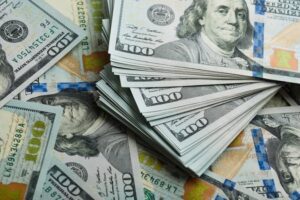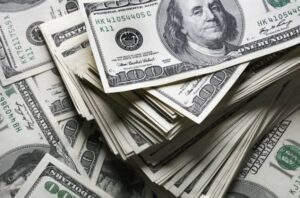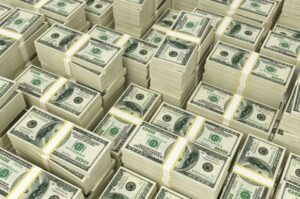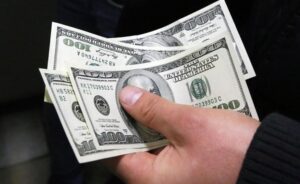
The U.S. dollar weakly appreciates against the euro and the pound sterling during the trading on Wednesday, continues to weaken in pair with the yen.
The day before the American currency plummeted in price following the release of the U.S. Labor Department data which showed a significant slowdown in inflation in the United States in November.
Last month consumer prices (CPI) rose by 7.1% year-on-year – the lowest since December 2021. The rate of inflation was down from 7.7% in October. Experts polled by Market Watch had on average expected a less significant slowdown to 7.3%.
The published statistics boosted investor hopes that the Federal Reserve (Fed) could halt the cycle of prime rate hikes sooner than previously expected.
The Fed concludes its two-day meeting on Wednesday. An overwhelming majority of experts expect the U.S. central bank to slow the pace of rate hikes in December after increasing it by 75 basis points (bps) at the end of the previous four meetings. The rate is expected to rise by 50 basis points to 4.25-4.5% at the December 13-14 meeting.
The euro/dollar pair traded at $1.0629 as of 8:00 a.m. Kk on Wednesday, compared to $1.0634 at the close of the previous session.
The pound exchange rate is $1.2257 by that time against $.2365 the day before.
The dollar fell to 135.44 yen against 135.59 yen at the previous trading session.
On Tuesday the American currency fell by 0.9% against the euro, by 0.8% against the pound and by 1.5% against the yen.
Meetings of the European Central Bank (ECB), the Bank of England as well as the Swiss and Norwegian central banks will also take place this week.
The European Central Bank, which meets on Thursday, may also slow the pace of key rate hikes to 50bp after increasing them by 75bp in October and September, experts expect.
The Bank of England, like the ECB, will hold a meeting on December 15. Analysts expect the British Central Bank, which raised its prime rate in November by 75 basis points. – maximum since 1989, will also decide to slow the rate increase to 50 bp.
EURO, pound, U.S. dollar, yen

The US dollar is stable against the euro and the pound sterling in trading on Tuesday, strengthening slightly against the yen.
Traders this week are focusing on meetings of several major global central banks, including the Federal Reserve (Fed), the European Central Bank (ECB), the Bank of England and the Swiss and Norwegian central banks.
The vast majority of experts expect the U.S. Central Bank to slow the rate hike in December after increasing it by 75 basis points (bps) at the end of the previous four meetings. The rate is expected to be raised by 50 bps to 4.25-4.5% at the Dec. 13-14 meeting.
On Tuesday, the U.S. Department of Labor will release November data on the country’s consumer price dynamics, which will allow investors to make predictions about how high the Fed’s rate cap will be in the current hike cycle.
Experts, according to Trading Economics, on average expect the rate of inflation in the United States to slow to an annualized rate of 7.3 percent last month, down from 7.7 percent in October. Core inflation, which excludes food and energy prices, is expected to slow to 6.1% in November from 6.3%.
The inflation data are even more important than the Fed’s decision, said Xi Qiao, managing director of UBS Group AG’s Wealth Management unit.
“The future dynamics of the U.S. central bank rate will depend on the rate of inflation whether or not the Fed slows the rate hike on Wednesday,” Xi Qiao said on Bloomberg TV.
IG Australia experts expect the dollar to decline if Tuesday’s Labor Department report shows a slowdown in U.S. inflation to 7-7.2 percent.
The European Central Bank, which meets on Thursday, may also slow the pace of key rate hikes to 50 bps after raising them by 75 bps in October and September, experts expect.
The euro/dollar pair was trading at $1.0542 as of 7:45 a.m. Ksk on Tuesday, up from $1.0539 at the close of the previous session.
The pound exchange rate by that time is $1.2274 against $.2273 the day before.
The Bank of England, like the ECB, will hold a meeting on December 15. Experts expect the British Central Bank, which raised its benchmark rate by 75 basis points in November to the highest level since 1989, will also hold a meeting. – the most since 1989, will also decide to slow the pace of the increase to 50 bps.
“We believe most Bank of England policymakers view a 75bp rate hike as an emergency move rather than the new normal,” notes BNP Paribas economist Paul Hollingsworth.
The ICE-calculated index showing the dollar’s performance against six currencies (euro, Swiss franc, yen, Canadian dollar, pound sterling and Swedish krona) lost 0.12% on Tuesday, while the broader WSJ Dollar Index lost 0.03%.
The dollar-yen exchange rate rose to 137.71 yen in trading, up from 137.64 yen at the close of the previous session.

The U.S. dollar is stable against the euro in trading on Friday, getting stronger against the pound and cheaper against the yen.
Traders will focus on the U.S. labor market report for November, which will be released at 3:30 p.m. Ksk.
The consensus forecast of experts polled by Trading Economics expects the number of jobs in the U.S. economy to increase by 200,000 in November and unemployment to remain at 3.7%.
The November labor market report is important to the Federal Reserve (Fed), which will hold its next meeting on December 13-14. Judging by futures quotations for the prime rate, the market expects the Fed to raise it by 50 bps. – to 4.25-4.5% per annum.
A new dot plot of forecasts will also be published at the end of the December meeting, reflecting the individual expectations of the members of the Federal Reserve Board of Governors and the heads of the Federal Reserve Banks with regard to interest rates.
Earlier this week, U.S. Central Bank Chairman Jerome Powell confirmed that the Fed could slow its rate hike as early as December.
Fed Vice Chairman of Banking Supervision Michael Barr on Thursday also argued in favor of a slower rate hike.
“We’ve been moving very, very quickly toward a rate level that would limit economic activity, and now that we’re very close to it, I think it makes sense to slow the pace of the hike,” Market Watch quoted Barr as saying.
The euro/dollar pair was trading at $1.0529 as of 8:20 a.m. Ksk Friday, up from $1.0527 at the close of the previous session. The pound fell to $1.2239, compared to $1.2256 at the close of trading on Thursday.
The dollar-yen exchange rate declined to 135.08 yen in trading, compared to 135.34 yen at the close of the previous session.
The ICE-calculated index showing the dollar’s dynamics against six currencies (euro, Swiss franc, yen, Canadian dollar, pound sterling and the Swedish krona) lost 0.01% on Friday, while the broader WSJ Dollar Index lost 0.04%.

The U.S. dollar is strengthening against the euro and the pound sterling in trading on Monday, becoming cheaper in pair with the yen.
The yuan exchange rate is declining amid the ongoing protests in China against covid restrictions.
The situation in China led to a decrease in appetite for risk in world markets that supports the dollar and yen, which are considered as “safe haven” currencies.
According to Bloomberg, protests were held in cities across the country, including the capital Beijing, as well as Shanghai, Xinjiang and Wuhan, which was originally the epicenter of the spread of COVID-19.
The ICE-calculated index showing the dynamics of the dollar against six currencies (euro, Swiss franc, yen, Canadian dollar, pound sterling and Swedish krona) added 0.39% on Monday, while the broader WSJ Dollar Index gained 0.25%.
The euro/dollar pair is trading at $1.0354 as of 7:55 a.m. Ksk, up from $1.0400 at the close of the previous session. The pound fell to $1.2050, compared to $1.2094 at Friday’s close.
The dollar fell to 138.44 yen against 139.19 yen at the close of the previous session. The euro slid down to 143.28 yen from 144.75 yen.
The U.S. currency pair with the yuan rose to 7.2053 yuan against 7.1654 yuan on Friday. The value of the dollar against the offshore yuan (traded in Hong Kong) rose to 7.2249 yuan from 7.1920 yuan.

The U.S. dollar is stable against the euro and the yen in trading on Friday, strengthening against the pound sterling.
A day earlier, the dollar fell in price against the world’s major currencies after the publication of the minutes of the Federal Reserve (Fed) meeting in November, which showed that the overwhelming majority of the U.S. central bank sees the need to slow the pace of rate hikes in the near future.
The ICE index showing the dollar’s performance against six currencies (euro, Swiss franc, yen, Canadian dollar, pound sterling and Swedish krone) lost 0.17% on Friday, while the broader WSJ Dollar Index was steady.
The euro/dollar pair is trading at $1.0411 as of 8:10 a.m., up from $1.0413 at the close of the previous session.
The dollar is trading at 138.66 yen against 138.64 yen the day before. The pound fell to $1.2099 from $1.2117.
On Thursday, the dollar fell 0.2% against the euro, 0.7% against the yen and 0.5% against the pound.
“Some of the Fed leaders observed that monetary policy had reached a state in which it was sufficiently restrictive to meet FOMC goals and it would be appropriate to slow rate hikes. The vast majority of meeting participants felt that a slowdown in the pace of the hike would probably be appropriate soon,” the minutes of the Nov. 1-2 Fed meeting noted.
Some of the U.S. central bank leaders, meanwhile, believed that the Fed would have to raise the rate higher than previously planned in order to meet its goal of easing inflation.
They indicated that the rate “will have to reach a somewhat higher level than previously expected,” given the lack of sufficient signals of easing inflation in the U.S. at the moment, as well as the continuing imbalance of supply and demand in the economy.

The U.S. dollar is getting cheaper against the euro, is stable against the British pound and rises against the Japanese yen in trading on Wednesday morning.
The ICE-calculated index showing the dollar’s dynamics against six currencies (euro, Swiss franc, yen, Canadian dollar, pound sterling and Swedish krona) is losing 0.13%, while the broader WSJ Dollar is down 0.03%.
The focus for traders this week is the minutes of the Federal Reserve’s November 1-2 meeting, at which the U.S. central bank raised its benchmark interest rate by 75 basis points (bps) and hinted at the possibility of a slowdown in its rate hike.
The minutes of the meeting will be published on Wednesday at 9 p.m. The experts expect the report to show that the Fed’s leaders reached a consensus on the need to slow the rate hike, Bloomberg wrote. However, there’s no consensus among them as to what interest rate cap will start to slow economic activity and lower the rate of inflation.
The euro/dollar pair is trading at $1.0329 as of 8:30 Moscow time, down from $1.0306 at the close of the previous session.
The dollar rose to 141.34 yen in trading against 141.22 yen on Tuesday.
The pound exchange rate was stable at the level of $1.1887 at the close of the previous session.
Meanwhile, the Chinese yuan was falling 0.19% against the dollar to settle at 7.1541 yuan per $1 as of 8:40 Moscow time. Investors are worried about new lockdowns in major Chinese cities because of a new outbreak of the coronavirus in the country which may trigger a slowdown in economic growth.